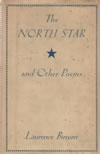
BC. Laurence Binyon
 |
|||
| A, b, and c are reprinted in The North Star and Other Poems, 1941. |
24. Koya San: Four Poems from Japan. London: Red Lion, 1932.
An edition of 110. From the ‘opening’ of Japan to the West in the nineteenth century through the first third of the twentieth, the country provided setting and detail for a host of British and American poets who knew little of the culture but nonetheless produced exotic evocations of it that were much in demand. For Binyon such a practice was anathema. His first mention of Japan in verse comes here, in his twenty-eighth collection of poems, after he had studied Japanese culture and aesthetics for a quarter century and had travelled in the country. The poems neither sentimentalise nor condescend, and are early examples of a sober receptiveness to Japanese culture that remains even now the exception rather than the rule in English-language poetry about the country. KOYA-SAN, MATSUSHIMA, and MIYAJIMA are reprinted in The North Star and Other Poems (London: Macmillan, 1941), which includes as well a note page explaining the settings of the former two. Binyon wrote at least one other poem during his stay in Japan, but it has not been published (see A20 and BC34b).
 |
 |
 |
a. Koya-San. The speaker recalls an ascent along the path ‘shrouded in vast trees’ to the ‘inmost Shrine’ of Kôyasan, the great Shingon monastery at Mt. Kôya in present-day Wakayama Prefecture, and the pilgrim he saw there, ‘unconscious of all else but his heart’s prayer’. The description focuses on the serenity and great natural beauty of the mountain. The note page in The North Star identifies the ‘shrine’ the pilgrim stands before as ‘the grave of the famous Buddhist saint Kobo’, a reference to Kôbô Daishi, the honorific name for Kûkai (Ap), founder of the monastery at Kôyasan. Hatcher (43) rightly calls the work ‘one of [Binyon’s] most fully achieved meditative poems’. Details reworked in the poem, and notes about the circumstances of Binyon’s visit to Kôyasan, may be found in a letter to his daughter of 20 November 1929 (see 33c).
b. Matsushima. A celebration of the famous view of one of the Nihonsankei, ‘three views of Japan’, the traditionally-designated three most beautiful sights in the country.
c. Miyajima. Binyon’s celebration of Miyajima, a second of the Nihonsankei, the beautiful forested island and Shintô complex in Hiroshima Bay, is more sentimental and less grounded in concrete details than preceding poems. He recalls the visit to Miyajima in the 20 November 1929 letter to his daughter; Yashiro Yukio (Ap), who accompanied Binyon to the island, recalls details of the composition of the poem in 38.
d. Hakone. Hakone, a town famous for its views of Mt. Fuji, was one of fifty-three post stations on the Tôkaidô, the 303-mile ‘Eastern Sea Road’ that from ancient times connected Osaka and Kyoto with Edo (modern-day Tokyo, particularly associated with the reign of the Tokugawa, 1603-1867). Binyon’s poem describes an autumn scene in which the speaker wonders if in ‘a different birth’ he paused ‘at this same path’s turning’ to smell the earth and relish the view, a question more sensitive to Japanese conceptions of Buddhism than most English-language poets would have been able to manage in the 1920s.

